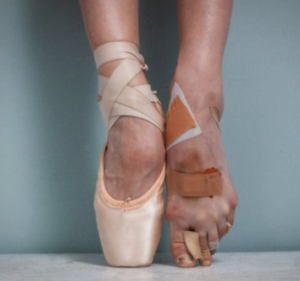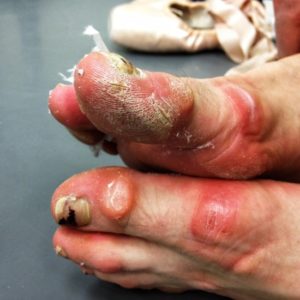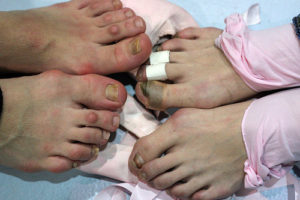We’ve all seen the photos.
You know the ones…
Like this.

Or this.

These are some of the common photos you’ll see online when searching “ballerina feet” or “common toe problems for dancers.”
The hard truth is this: Ballet definitely takes a toll only a dancers feet.
Yes and no. It depends on the dancer, training schedule, genetics, and medical advice.
Dancing on pointe is hard — very hard. Dancers train for years to place all of their weight on their toes as they dance on pointe, and they’re expected to train at this hours upon hours, each week, and ultimately perform.
Blisters, bunions, corns and ingrown nails are common problems that occur when dancing on pointe, but they can be greatly exacerbated if untreated. Which brings us the main reason why ballet dancers feet go through so much damage.
Professional dancers are known to go on stage with a battery of injuries from growths, to stress fractures and complete breaks. It’s these injuries and continued stress on minor ones that lead to feet looking like this.

Minor injuries like blisters, bunions, and corns, can develop sinuses and become ulcers. And while podiatrists are able to provide treatments and care for these injuries such as treating the infections with antibiotics, the rigorous ballet training schedule won’t allow for proper healing.
But daily training is the norm in professional ballet, and taking a week to a month off can be “catastrophic” for a dancers career. After all, dancers do not want to be seen as the member of the company that is always injured, that’s “no bueno” come audition time. So taking time off is something most professional dancers will not do.
Common Feet Remedies are Temporary Solutions
If you’re a dancer looking for ways to reduce the visible impact on your feet from dancing, then think again. Toe pads, wraps, and moleskin are temporary solutions used to alleviate some of the pain from blisters and corns. But they’re far from a permanent one. As mentioned earlier, the continued time spent dancing with these minor injuries leads to the shocking pictures like the ones above.
However, if you treat your feet well, regularly see a podiatrist, and take occasional time off to let your feet heal, then you’ll be OK.
What to do if you’re concerned about your feet?
See a podiatrist or medical professional immediately. Regardless of the pain or discomfort level, it’s important to make sure there is no major underlying issue. Regular check-ups on your feet will ensure that you’re able to dance professionally for a very long time, and will help prevent the frequency of minor injuries as well as major ones.
Does Ballet Ruin Your Feet?
Ruin your feet? No. But does dancing leave you with signs that you’ve spent hours of dedication to one of the toughest sports in the world, then yes. People who refer to a dancer’s feet as “ugly” should think again. I see a dancer’s feet and I immediately recognize the hard work and dedication they have put in. If you look at any professional athlete, their body will be covered in scars from years of training and top level competition. The same goes for ballerinas.
Dancers train to deal with minor pain and injuries, and as the saying goes, “the show must go on.” Regardless of cracked metatarsals or stress fractures, ballet dancers are some of the most graceful and toughest athletes alive.
